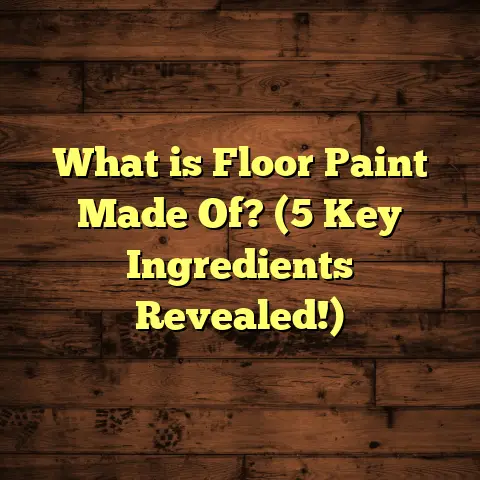What Is Linoleum Flooring? (5 Benefits for Stylish Homes)
I still remember the moment I decided to revamp my living space. The old carpet was worn out, the tiles had cracks, and I wanted something that felt natural, durable, and stylish but didn’t involve a massive budget or endless upkeep. I needed a solution that fit my lifestyle—not just a flooring option but something that brought warmth and character to my home. That’s when I came across linoleum flooring. Honestly, I thought linoleum was something my grandparents used decades ago, something outdated and plain. But after spending some time researching and even installing it myself in a few rooms, I realized how wrong I was. Linoleum is making a strong comeback, and stylish homes everywhere are benefiting from its unique qualities.
What Is Linoleum Flooring?
Let’s start with the basics: what is linoleum flooring? Simply put, linoleum is a type of resilient flooring made from natural materials. The main ingredients include linseed oil (extracted from flax seeds), pine rosin, wood flour, cork dust, and natural pigments. These materials are blended together and applied as a sheet onto a backing made commonly of burlap or jute fabric. The result is a flexible, durable sheet that can be cut and installed in almost any room.
Unlike vinyl flooring—which is synthetic and petroleum-based—linoleum is mostly natural and biodegradable. This means it’s one of the more environmentally friendly flooring options out there. It has been around since the late 19th century but has evolved significantly in terms of design and durability.
I find it fascinating how something made from such simple ingredients can create a floor that not only looks great but also stands up to years of wear and tear.
A Personal Journey With Linoleum
When I first installed linoleum in my kitchen, I wasn’t sure what to expect. The room gets heavy foot traffic, occasional spills, and is home to two energetic kids and a curious dog. What impressed me immediately was how comfortable it felt underfoot—warmer than tile or stone—and how easy it was to clean after dinner messes.
Over the years, this floor has taken everything in stride—scratches are minimal, stains wipe away easily, and it still looks fresh. This personal experience convinced me to recommend linoleum to many clients who want a blend of style, practicality, and sustainability.
Now, let me share with you five key benefits that make linoleum an excellent choice for stylish homes.
1. Eco-Friendly and Sustainable: Flooring That Cares for the Planet
One thing I’ve come to appreciate deeply about linoleum is its eco-friendly nature. Unlike vinyl flooring, which relies on PVC (a plastic that’s tough on the environment), linoleum uses natural materials that come from renewable sources.
Linseed oil is harvested from flax plants; cork dust comes from the bark of cork trees without harming the tree; wood flour is a byproduct of wood processing; pine rosin is derived from pine trees. Because these ingredients are biodegradable, linoleum floors can break down naturally over time—usually within six months under the right conditions.
According to the Linoleum Manufacturers Association, linoleum is among the few flooring options that are 100% natural and compostable. When you choose linoleum, you’re reducing your carbon footprint and minimizing landfill waste.
I remember working with a client who was passionate about sustainable living. She chose linoleum for her entire home renovation because it aligned perfectly with her values. Knowing that the floor beneath her feet was environmentally responsible gave her peace of mind.
The Environmental Data Behind Linoleum
- Carbon footprint: Linoleum production results in significantly lower carbon emissions compared to vinyl or carpet manufacturing.
- Renewable content: Up to 97% of linoleum’s materials are renewable.
- Biodegradability: Linoleum breaks down naturally within six months to a year in composting environments.
- Low VOC emissions: Linoleum releases minimal volatile organic compounds (VOCs), improving indoor air quality.
These facts make it clear why linoleum is a favorite among eco-conscious homeowners.
2. Durability That Lasts Decades: Floors That Keep Up with Life
Durability is always at the top of my checklist when recommending flooring. A beautiful floor isn’t much use if it wears out quickly or shows scratches at the first sign of foot traffic.
Here’s where linoleum shines. It’s incredibly resilient against wear and tear. I’ve seen linoleum floors that have lasted over 40 years with only minor maintenance. Schools, hospitals, and restaurants often use linoleum because it withstands heavy foot traffic without losing its integrity.
How Does Linoleum Hold Up?
Linoleum’s durability comes from its composition: oxidized linseed oil forms a hard surface that bonds tightly with the fillers like wood flour and cork dust. This creates a tough but flexible material resistant to dents and abrasions.
A case study from a Midwestern school district documented their linoleum floors lasting over 15 years in high-traffic hallways before needing minor refinishing—not replacement. That saved them significant costs compared to vinyl or tile alternatives.
Real-World Results From My Experience
In one project, I installed linoleum in a busy family room where children played daily with toys and pets ran around. After three years, there were no visible scratches or signs of wear despite heavy use.
This durability isn’t just about toughness; it also means fewer replacements over time—good news for your wallet and the environment.
3. Style Versatility: Designs for Every Taste
If you think linoleum is boring or outdated in style, think again. Modern linoleum comes in an astonishing variety of colors, patterns, and textures.
Thanks to advances in printing technology, manufacturers can produce linoleum that mimics natural stone, wood grain, marble veining, or vibrant abstract patterns.
When I renovated my kitchen, I found a beautiful gray marbled pattern that complemented my minimalist décor perfectly. I’ve also seen clients opt for bold geometric designs or subtle speckled textures that hide dirt well.
Linoleum can be customized to fit almost any interior style—from vintage charm to sleek modernism.
Why Style Matters for Flooring
Flooring sets the tone for your entire room. Whether you want your space to feel cozy or contemporary, your floor choice plays a huge role.
Because linoleum comes in so many options, it’s easy to find one that matches your vision without compromising durability or maintenance.
4. Comfort Underfoot: A Floor You’ll Enjoy Walking On
I’ve always valued comfort in my home’s floors because I spend lots of time standing while cooking or cleaning.
Linoleum offers subtle cushioning due to its flexible backing layer (often made from jute). This means it’s softer than tile or stone but still firm enough to support furniture without denting.
Scientific studies suggest floors with slight elasticity reduce foot fatigue and joint strain—something I noticed immediately after switching my kitchen floor to linoleum.
For families with small children or elderly members who spend significant time standing or walking indoors, this added comfort can make a big difference.
How Linoleum Compares Comfort-wise
- Tile/Stone: Hard and cold; can cause discomfort during prolonged standing.
- Hardwood: Warm but less cushioned; scratches easily.
- Vinyl: Softer but synthetic; can feel less natural.
- Linoleum: Balanced firmness with slight cushioning; natural materials give it warmth underfoot.
If you want a floor that feels good as well as looks great, linoleum fits that bill well.
5. Low Maintenance Without Sacrificing Appearance
One of my favorite things about linoleum is how simple it is to care for—especially when compared to hardwood or carpet.
Regular sweeping or vacuuming removes dust and grit that could scratch the surface. A quick mop with mild detergent keeps it sparkling clean.
Linoleum resists bacteria and mold growth naturally due to its dense surface structure—an important benefit for homes with kids or pets prone to spills or accidents.
I’ve helped clients who were amazed at how little effort it took to keep their floors looking new after years of use.
Maintenance Tips That Work for Me
- Sweep daily or as needed.
- Mop weekly with water and mild floor cleaner.
- Avoid harsh chemicals or abrasive scrubbers.
- Apply polish every 3-5 years depending on wear.
- Wipe spills immediately to prevent staining.
Following these easy steps keeps linoleum floors vibrant without requiring special products or treatments.
How Linoleum Is Made: An Inside Look at Its Construction
Understanding how linoleum is manufactured helps explain why it works so well as flooring.
The key ingredient—linseed oil—is extracted by pressing flax seeds. This oil then undergoes oxidation (exposure to air) which causes it to harden into a solid form called “linoxyn.”
This hardened oil binds together wood flour (fine wood particles), cork dust (which adds softness), pine rosin (for stickiness), and pigments (for color).
This mix is spread onto a jute backing fabric in sheets. After curing (drying), the surface may be coated with protective layers like polyurethane or wax for extra durability and stain resistance.
The result is a resilient sheet material that combines strength with flexibility—perfect for flooring applications.
Installation Insights: What You Should Know Before Laying Linoleum
Installing linoleum isn’t rocket science but does require attention to detail for best results.
Linoleum typically comes in large sheets or tiles that must be cut precisely to fit your space. You’ll need tools like a utility knife and straight edge for clean cuts.
The subfloor needs to be flat, smooth, dry, and free of debris before installation. Uneven surfaces can cause bumps or bubbles under the floor later on.
Adhesives specially formulated for linoleum secure the sheets firmly in place—professional installation helps ensure seams are tight and no lifting occurs over time.
I usually recommend hiring an experienced contractor unless you’re confident with DIY flooring projects because mistakes during installation can affect durability and appearance significantly.
Comparing Linoleum With Other Flooring Choices
People often ask me how linoleum compares against other popular floors like vinyl, hardwood, tile, or laminate. Here’s what I’ve learned over years of hands-on experience:
Linoleum vs Vinyl
Vinyl is cheaper upfront but made from PVC plastic which isn’t biodegradable and may emit VOCs affecting indoor air quality. Linoleum is natural, more breathable, and better environmentally but costs slightly more initially.
Vinyl can mimic many styles but doesn’t breathe well nor age as gracefully as linoleum does over decades.
Linoleum vs Hardwood
Hardwood offers unmatched beauty but is expensive, prone to scratches, dents, and moisture damage. Linoleum mimics wood grain patterns affordably while being easier to maintain and more moisture-resistant.
Linoleum vs Tile
Tile is extremely durable but cold and unforgiving underfoot; grout lines require cleaning regularly too. Linoleum provides warmth and softness while still holding up well against daily wear.
Linoleum vs Laminate
Laminate often has synthetic layers vulnerable to moisture damage. Linoleum’s natural composition offers better breathability plus longevity with proper care.
Real Client Stories: Success With Linoleum Floors
Over the years, I’ve worked on many projects involving linoleum installation, each providing unique insights:
- Family Kitchen: Heavy use by kids + pets = no scratches after 3 years.
- Boutique Store: Custom patterned linoleum added style while standing up to foot traffic.
- Eco-Friendly Home: Entire house floored with linoleum aligned with sustainable goals.
- School Hallways: Over 15 years with only minor refinishing needed.
These cases prove how versatile and practical linoleum truly is across different settings.
Linoleum Trends: Why It’s Gaining Popularity Again
I’ve noticed designers increasingly specify linoleum because it meets multiple demands: eco-friendliness, durability, comfort, style flexibility—all at reasonable cost.
Its ability to be printed with custom patterns makes it perfect for unique spaces wanting personality without sacrificing function.
Plus, as more people seek healthier homes avoiding synthetic chemicals, natural materials like linoleum make more sense than ever before.
Cost Breakdown: What Does Linoleum Flooring Cost?
Cost is always top of mind when choosing floors. Prices vary depending on brand, thickness, pattern complexity, and installation method:
- Material: $2 – $5 per square foot
- Installation: $2 – $6 per square foot
- Total Average: $4 – $11 per square foot installed
Compared to hardwood ($8-$15/sq ft) or tile ($5-$10/sq ft), linoleum offers good value considering lifespan (20+ years).
Budget-wise, it fits mid-range projects well without sacrificing quality or aesthetics.
Common Questions About Linoleum Flooring
Here are some questions clients frequently ask me:
Q: Is linoleum waterproof?
A: Not fully waterproof but water-resistant if sealed properly; avoid standing water exposure long-term.
Q: Can I install linoleum over existing floors?
A: Yes, if subfloor is smooth and stable; often installed over concrete or plywood.
Q: How do I repair damaged spots?
A: Small cuts can be patched; larger damage may require replacing whole sheets section.
Q: Is it safe for allergy sufferers?
A: Yes! Natural materials mean fewer allergens trapped compared to carpet; low VOCs improve air quality too.
Q: How often should I refinish?
A: Every 3-5 years depending on wear; professional polish restores shine and protection.
Final Reflections on Linoleum Flooring
Looking back on my journey with linoleum flooring—from initial doubts to becoming a firm advocate—I’m convinced it deserves serious consideration for any home renovation or new build.
It combines natural beauty, toughness for everyday life, comfort underfoot, low maintenance needs, and environmental responsibility in one package.
If you want your floors to look great while supporting a healthier planet and lifestyle, why not give linoleum a closer look? It’s been part of my home for years now—and I couldn’t be happier with how it performs day after day.
What about you? Are you ready to add some natural charm and durability underfoot?





